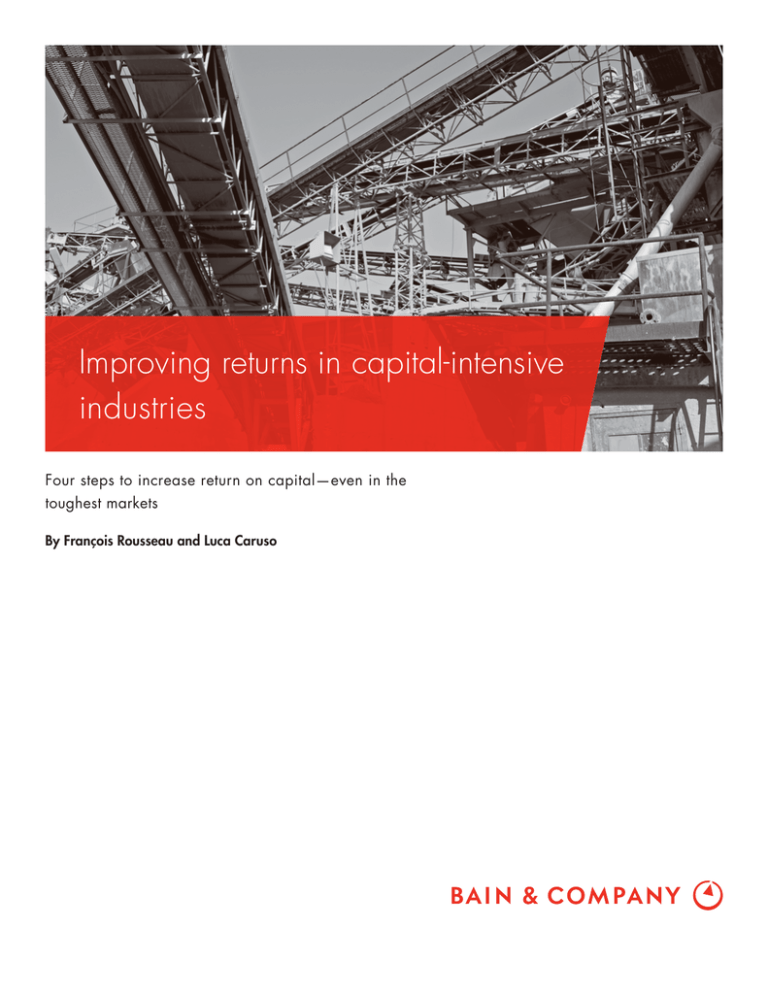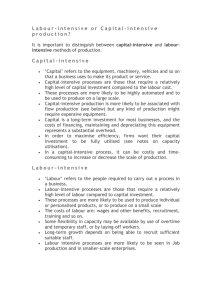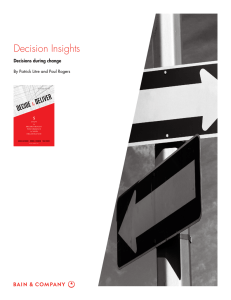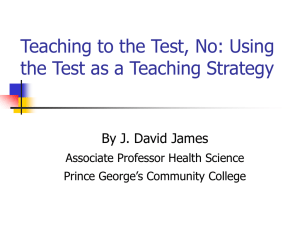
Improving returns in capital-intensive
industries
Four steps to increase return on capital—even in the
toughest markets
By François Rousseau and Luca Caruso
François Rousseau is a partner and director with Bain & Company in the Paris
office. He leads Bain France’s Industrial Goods & Services practice. Luca Caruso
is a partner and director with Bain & Company’s London office. He is the leader
of Bain’s European Industrial Goods & Services practice and a founder of
Bain’s Oil & Gas practice.
Copyright © 2015 Bain & Company, Inc. All rights reserved.
Improving returns in capital-intensive industries
Capital-intensive industries exist in a world of painfully
low margins. The pressure to realize profits is typically
so intense that many management teams struggle just
to keep return on capital employed (ROCE) above the
cost of capital.
processes are no longer proprietary. Global equipment
suppliers and experienced managers rapidly infuse new
and smaller players with industry expertise, helping
them narrow the gaps in cost and efficiency with established players.
A Bain study of 30 companies across five industries—
paper, steel, cement, aluminum and tires—shows that
most companies deliver similarly low returns. The distribution of ROCE for capital-intensive industries over
the past 25 years centers on a median value of only 5.4%,
according to the study (see Figure 1).
Management teams have several options to compete more
effectively in a changed landscape. Improving returns
starts with rethinking where to play—and with four strategic steps that many companies often overlook when
it comes to improving performance.
Where to play: A more profit-focused portfolio
The root cause of lower returns is clear. A superabundance
of global capital has fueled excess supply in industries such
as cement, steel and paper. A chronic supply–demand
imbalance, in turn, has forced prices down and depressed
profits. Yet capital to finance capex-intensive industries remains widely available—a paradox given their low ROCE.
The most pressing issue for leadership teams in capitalintensive industries is whether to stay in businesses in
which margins have been relentlessly driven down.
Many companies are choosing to exit low-profit businesses that once were considered to be core. As they
rebalance their portfolios, they are migrating up the
value-added chain, investing in related sectors where
new technologies can provide competitive advantages.
At the same time, traditional barriers to entry have fallen.
Technologies are now widely available and industrial
Figure 1: The median value for return on capital employed (ROCE) in capital-intensive industries is only 5.4%
ROCE distribution for integrated players in aluminium, cement, paper, steel and tire industries
(Number of observations, 1990–2014)
Median: 5,4%
90
st
1 decile
80
9 th decile
70
60
ROCE collapse in
aluminum, paper and
steel industries
2008–2013
50
40
ROCE peak in aluminum
and steel industries
2003–2008
30
20
10
0
–10%
0%
5%
10%
20%
ROCE
Notes: n=5 for aluminum; n=5 for cement; n=9 for paper; n=7 for steel; n=4 for tires
Sources: Capital IQ; Bain analysis
1
30%
40%
Improving returns in capital-intensive industries
German steelmaker ThyssenKrupp, for example, sold
its loss-making American steel finishing plant in 2013
for $1.55 billion in a restructuring shift away from the
volatile steel business into higher-margin products and
services such as elevators, factory components, auto parts
and marine services.
New developing market entrants in capital-intensive
industries have built a strong competitive advantage by
keeping capex relatively low. By contrast, the focus on
cutting costs at many established players means they
sometimes lose sight of improving capex. One way to
get the balance right: Develop a more disciplined approach to managing capex, and benchmark the company’s performance against the industry’s leaders.
Profit pool mapping is an important tool for assessing
whether and where it makes sense to do business. In
heavy industries, management teams often are so
focused on volumes and tonnage that they overlook
where the biggest profit pools are. By understanding
the sources and distribution of profits across their industry, companies can gain an inside edge on improving returns.
Cost discipline makes a critical difference. One-time
efforts usually fail to deliver savings that stick, as our
research shows. One explanation is that in tough times,
management teams are quick to cut costs, but when the
cycle swings up, they tend to take their eye off cost improvement and focus on growth-related priorities.
The premium end of the business typically represents
a very large proportion of the profit pool. The best opportunities often cluster there for companies competing in capital-intensive industries. German tire maker
Continental, for example, builds premium products that
help it capture three times more economic profit than
global scale leader Bridgestone. Continental’s better
customer mix translates to a deeper profit pool.
Developing a rigorous approach to cost improvement and
nurturing the right capabilities to optimize working capital can help capital-intensive companies outperform.
With cash flow down significantly in the wake of declining metal prices, one large integrated mining company
launched a three-year program that reduced costs by 15%,
increased production volume and delivered several
billion dollars in productivity gains.
Picking the right place to play in the value chain is
also critical to improving returns—and the most profitable spot varies across industries. In seamless tube
manufacturing, premium connections—a downstream
activity—assure perfect sealing after seamless tubes
are assembled, driving much higher returns than the
upstream activities of tube manufacturing. As a result,
a small part of the downstream business makes most
of the margin.
2. Build the lowest-cost position
Geography is another key factor for improving returns.
Investing in geographies that offer the lowest landed
cost position can create a strong competitive advantage.
It’s particularly important in asset-heavy industries
where the one-time cost of closing and moving businesses is high.
The best-performing firms revisit their geographic footprint regularly, as cost dynamics are constantly evolving.
French tire maker Michelin launched a €170 million
four-year investment program in Serbia in 2012 to take
advantage of a low-cost production zone, doubling their
production capacity for entry-level tires.
How to win: Four strategic steps to improving
returns
1. Improve the cost base and review capex continually
In capital-intensive industries where low returns have
become endemic, reducing costs and improving capex
efficiency are important ways to improve performance.
Indeed, capital allocation is just as important as cost—
a fact that many companies overlook.
A global diversified specialty chemicals company based
in the US decided to trim its geographic footprint, reducing
the total number of plant locations by 32%. The shift
improved the company’s ROCE in two ways: It reduced
2
Improving returns in capital-intensive industries
In fact, according to Bain’s study of mergers and acquisitions, the more deals a company does and the more
material those deals are to the company’s overall market
capitalization, the better the returns. During the 11-year
period from 2000 through 2010, companies that averaged more than one deal per year—with deals adding up
to more than 75% of the buyer’s market cap—turned in
an average total shareholder return well above that of
companies in other categories. M&A, in short, is an
area where experience and expertise matter a great deal.
the capital tied up in property, plant and equipment by
5%, and it increased its profit margin. The exercise also
helped create clearer performance metrics for underperforming assets.
No question, some asset-heavy industries such as chemicals face special challenges in rationalizing their geographic footprint. If the value of aging plants is low and
labor is not a significant cost factor, for example, the
one-time cost of closing and moving assets to lowcost geographies can be hard to justify using strictly
financial criteria.
Companies that are most experienced in M&A build
their capabilities over time. They search hard for merger
or acquisition candidates that will add to their operating
profit and fuel balanced growth. They pursue nearly as
many scope deals as scale deals, moving into adjacent
markets as well as expanding their share of existing markets. Most importantly, they create Repeatable Models®
for identifying, evaluating and then closing good deals.
What they typically find is that there are plenty of good
prospects to be pursued and that the risk involved decreases with experience.
Clearly, companies that can choose the lowest-cost geography up front gain a competitive edge. Those in mature
industries need to weigh the short-term downside against
the longer-term benefits of reducing complexity.
3. Use mergers and acquisitions strategically
Smart acquisitions can help improve performance significantly, but many companies get off to a bad start by
investing at the top of the cycle, when prices are at their
peak, simply because that’s when cash is available.
Leadership teams that take a strategic, disciplined and
long-term approach to M&A instead of a tactical and episodic approach can improve returns significantly.
4. The service ace
For traditional capital-intensive industries, service can be
a highly profitable business in its own right, generating
better and faster return on investment than new production facilities, large-scale R&D programs or acquisitions.
Companies that nurture M&A as a core competence derive the greatest value from them. Their leadership teams
devote time to developing a structured roadmap of the
most attractive potential targets, making it easier to acquire
assets when the right opportunity comes along—and to
target acquisitions at the bottom of the cycle.
A recent Bain study across a broad cross-section of industrial companies showed that service contributed 22%
of total revenues and had an average gross margin of
39%—significantly higher than margins on most manufactured products. On average, the service business
of these companies grew by 9% annually between 2010
and 2014—nearly double the rate of new equipment
sales (see Figure 2).
That’s a tactic ArcelorMittal CEO Lakshmi Mittal turned
to his advantage in building the world’s largest steel and
mining company from a single mill. In an acquisition
spree spanning 25 years, Mittal acquired dozens of nearbankrupt steel mills in economic downswings—even
when his company was short on cash. He recognized
that despite the investments required to turn around
those acquisitions, the total capital invested would be far
lower than what would have to be invested in a greenfield plant.
Indeed, for many industrial manufacturers, investing
in service is the only way to sustainably grow profits in a
tough economic environment. Investing in a service
business also lowers capital intensity. A global leader in
power equipment decided to invest in service and software due to narrowing profit margins in its core equip-
3
Improving returns in capital-intensive industries
Figure 2: Investing in service can generate higher revenue growth and profit
Growth rate*
Gross margin
39%
9%
27%
5%
Service
Service
New equipment
New equipment
*Cumulative average growth rate between 2010 and 2013
Source: Bain 2014 Service Benchmarking Study (n=45)
ment business. Over the next three years, the company’s
service business grew three times faster than equipment
sales, balancing out a weakness in its core business. And
in 2014, its gross margin in service was 42% higher
than its gross margin in power equipment.
Getting there requires a strategic shift toward a more
profit-focused portfolio:
Investing in a world-class service business can become
a strategic ace, elevating a company above competitors
in an environment where differentiation on products
and cost is difficult to achieve. The range of service opportunities, some larger than others, will vary by industry and
company. Here again, mapping profit pools can help identify the potential size of service businesses and those
with the greatest returns.
There is no question that companies in capital-intensive
industries operate in a difficult environment today. But
leadership teams that commit to a bold ambition have
opportunities to break away from the pack and achieve
double-digit returns significantly above the cost of capital.
•
Find the most attractive profit pools in your businesses.
•
Adopt a mindset of continual cost improvement and
capex optimization.
•
Look for opportunities to drive down the company’s landed cost footprint by investing in the
right geographies.
•
Develop strong in-house M&A expertise and a structured roadmap of potential deals.
•
Invest in related service businesses.
Leadership teams that take these steps will not only give
returns a powerful boost, they also will help to rebuild
competitive advantage and position their companies to
win in a changed industrial landscape.
Repeatable Models® is a registered trademark of Bain & Company, Inc.
4
Shared Ambit ion, True Results
Bain & Company is the management consulting firm that the world’s business leaders come
to when they want results.
Bain advises clients on strategy, operations, technology, organization, private equity and mergers and acquisitions.
We develop practical, customized insights that clients act on and transfer skills that make change stick. Founded
in 1973, Bain has 53 offices in 34 countries, and our deep expertise and client roster cross every industry and
economic sector. Our clients have outperformed the stock market 4 to 1.
What sets us apart
We believe a consulting firm should be more than an adviser. So we put ourselves in our clients’ shoes, selling
outcomes, not projects. We align our incentives with our clients’ by linking our fees to their results and collaborate
to unlock the full potential of their business. Our Results Delivery® process builds our clients’ capabilities, and
our True North values mean we do the right thing for our clients, people and communities—always.
For more information, visit www.bain.com









